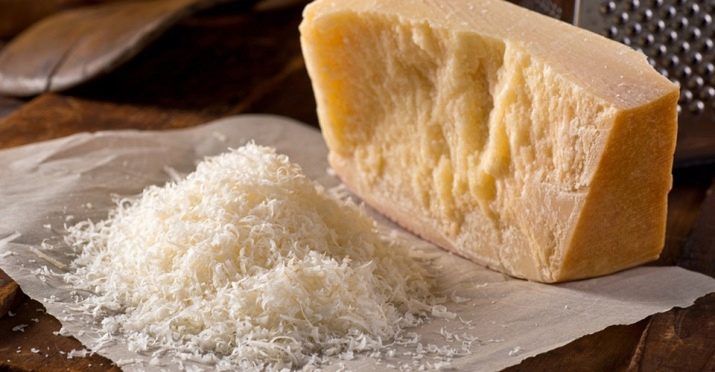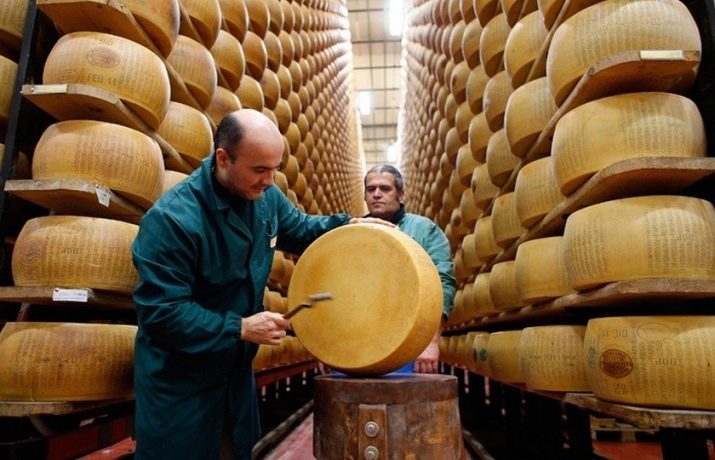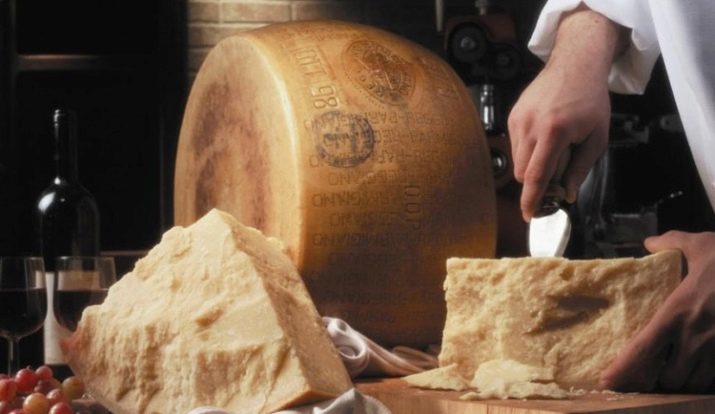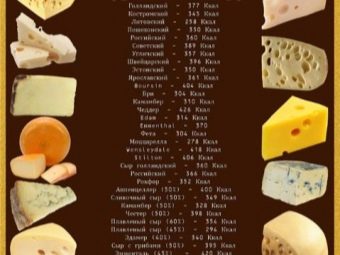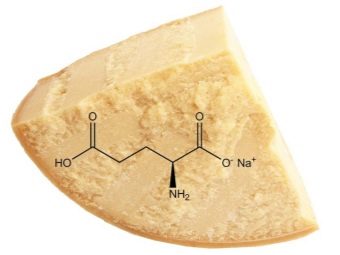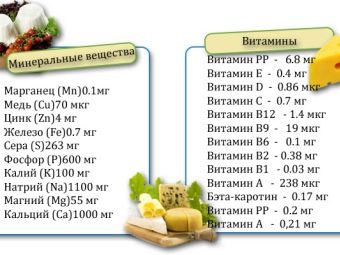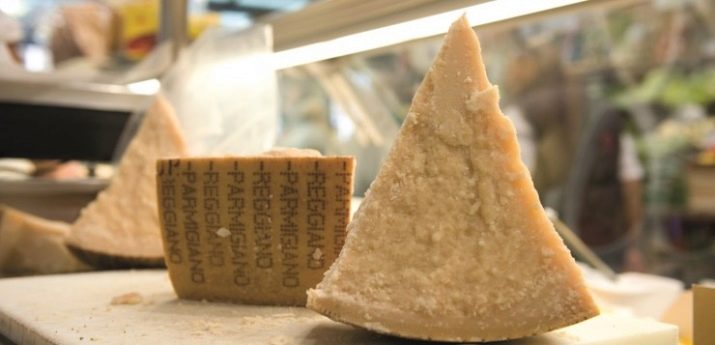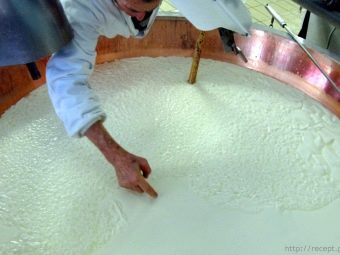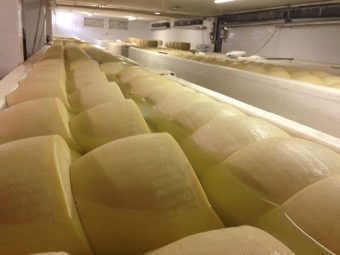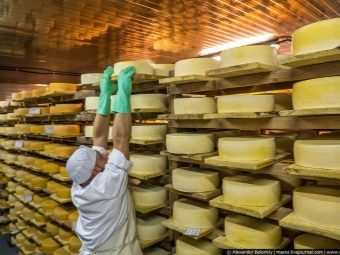Parmesan: what is it, how is it made and eaten?
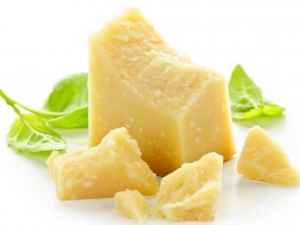
Parmesan cheese is one of the most well-known foreign dairy products.Most often it is used in the rubbed form for sprinkling pizza, pasta and risotto, as well as in salads, sauces and even soups. Despite the presence of sodium in the composition, this cheese is still considered very useful for the human body.
Special features
Hard Parmesan cheese, at first glance, has a very strange taste and smell, as well as an incomprehensible texture. It can not be cut into neat slices, the pieces just break off, which immediately raises the question of how to use it, and whether it is possible to add the product to other dishes. However, if you get to know Parmesan more closely, you will be able to appreciate all of its outstanding advantages. This Italian cheese is very brittle and has a granular-scaly structure. It is made from cow's milk in the Emilia-Romagna region. Therefore, in the case when the country of origin is not Italy, and even if the region is not Emilia-Romagna, then actually the cheese product cannot be called Parmesan.
The description of this type of cheese suggests that it looks like a very large, but low cylinder. Its sides are slightly rounded. The weight of one head can reach forty kilograms, the diameter - one and a half meters, and the height - twenty-five centimeters. The consistency is very firm, and the taste is quite pungent, salty and with hints of walnut.
Kinds
There are three types of Parmesan cheese, which differ in the longitude of exposure. The “fresh” product stays on the shelves before consumption to one and a half years, the “old” - from one and a half to two years, and “very old” - from two to three or even four years.
It is important to know that some species can mature up to a dozen years. The taste and weight of the head can be predicted depending on the age of Parmesan. For example, the “very old” sample will please with a bright salty taste, but less weight. The taste properties of the product may still depend on the time of production: summer Parmesan is much more interesting than autumn, because in summer cows feed on fresh grass, and in autumn - mostly hay.
Composition and nutritional value
100 grams of Parmesan cheese contains 35.75 grams of protein, 25.83 grams of fat and 3.22 grams of carbohydrates. The product is rich in a variety of beneficial substances. Among the vitamins, there are vitamin A, group B vitamins, vitamin D, vitamin E and vitamin K. Parmesan is rich in macronutrients such as potassium, calcium, magnesium and others, as well as trace elements: iron, copper, zinc and selenium.
It is important to mention about low cholesterol. The energy value of the product is usually 392 kilocalories per 100 grams, although the minimum amount may be 300 kilocalories.
It contains cheese and a substance such as monosodium glutamate, but since it is natural, unlike the chemical, it even benefits the body. We must not forget that the unique taste of Parmesan is made thanks to him. Monosodium glutamate activates metabolism and helps brain activity. The percentage of cheese fat content is between 25 and 32, which is by no means a large number. Most of all in Parmesan are about 35%. In general, the product of microelements is much more than in other cheeses, due to its high density.
Benefit
Parmesan cheese is especially useful for children whose body is in the formative stage, as well as for the elderly. This is due to the fact that the product contains many essential acids, calcium, which is responsible for the state of bones, phosphorus and other important substances. A large amount of protein is responsible for the normalization of the hormonal system and cellular renewal. Vitamin A is known to improve the condition of vision, skin and teeth.
Often the product is recommended for those recovering from an illness or extensive loads - low cholesterol and abundance of nutrients makes it an indispensable product for this purpose.
Parmesan is also recommended for women who feed children or are in a state of pregnancy - it will help to restore the lost elements.In addition, the product changes the state of the intestines for the better, helps to cope with insomnia and calm the nerves.
Harm
Almost the only case when Parmesan is harmful if it is consumed by a person with lactose intolerance, which is present in almost any dairy product. In addition, it is recommended to avoid feeding children with a tendency to diabetes and adults suffering from hypertension or having a heart attack. This rule is explained by the fact that the dairy product contains sodium, and it is absolutely not worth using it in these cases.
In addition, people with gastrointestinal diseases, those who are overweight, have chronic migraines, and have suffered from poisoning are in the minimum risk group.
Experts recommend limiting the daily dose of forty grams of the product.
How is it produced?
Real Parmesan cheese is made from cow's milk. Naturally, with numerous variations in different countries of the world, goat milk is also allowed to be consumed. Prepare it from a mixture of evening and morning product, and the evening is collected the day before, and in the morning it is freed from the cream.
The recipe is quite simple: the mixture in a copper vat is heated to a temperature of 35 degrees, after which natural rennet is introduced. Usually this is the gastric juice of a baby cow. After a certain time, a cheese clot should form - it is cut into small fragments and warmed to a temperature of 50 degrees. The last serum is removed while the product is on average fire for about an hour. Then a couple of hours already hard Parmesan will have to stay in the fabric, then the pieces are laid out in forms of wood with small internal spines, which will imprint on the head the name of the manufacturer.
A couple of days, the cheese is in this way, after which it falls into the brine for twenty days, and then matures on the shelves in special stores from one to three years. During this time, each head loses a few pounds of weight. Parmesan circles are stored on wooden shelves in a room where a constant temperature is maintained.
It should be mentioned that during aging, the product has to be periodically monitored, turned over and rid of excess liquid that appears - every seven days. After the first year of such a process, all heads knock on special instruments. If even small cavities and holes are found inside, then such cheese will be sold in the future already crushed. In addition, it can not be left to ripen - usually it immediately goes on sale.
The degree of ripening can also be checked with a hammer, hitting the piece properly. To get one kilogram of real cheese takes about sixteen liters of milk. A curious fact, but the preparation of Parmesan in the Emilia-Romagna region always begins on the first of April.
Application
First of all it should be recalled that the use of Parmesan in the usual way will not work - it is commonplace not cut into ordinary slices. To get a piece of cheese, you have to otkolupat piece on their own. Professionals for this always have a special small tool with a round handle and a sharp point. Most often, Parmesan dishes contain grated cheese: these include numerous pizzas, pastas, risotto, and salads.
Its main advantage compared to other varieties is that the Parmesan cheese will never roll into lumps or form excessive viscosity.
It combines cheese with various types of meat, as well as vegetables. As a rule, a practically cooked dish is sprinkled with cheese to make a crust.
Sometimes the grated product is directly mixed in breading, in which then pieces of the same meat, fish, or vegetables are rolled. There are recipes for cooking sauces with Parmesan, soups and stews.In Italy, cheese often serves as an independent snack - slices are dipped in balsamic vinegar and served with white and red wines. On a cheese plate, Parmesan cheese is usually accompanied by nuts, pears, figs, ham slices and fresh greens. Acceptable fat, low cholesterol and weight of nutrients explain why cheese is often eaten for weight loss. In addition, it is customary to make it in the menu with a sports diet.
How to store and is it possible to freeze in the freezer?
Shelf life of storage of whole piece of cheese in the refrigerator is calculated in several months. From the moment it is produced, Parmesan is able to retain its characteristics until six months have passed. However, the storage temperature should not exceed eight degrees. Ideally, place the product in the freezer - it bears the freezing process without any problems. It should also be added that after purchasing a cheese in a store, at home it must be wrapped first in parchment, then in foil. If Parmesan is purchased grated or simply fragmented, then it will need to be eaten in a week.
Interesting information about Parmesan can be found in the video below.

